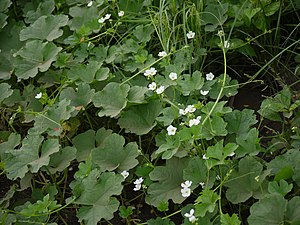Luffa echinata
| Luffa echinata | ||||||||||||
|---|---|---|---|---|---|---|---|---|---|---|---|---|

Habit, leaves and flowers of Luffa echinata |
||||||||||||
| Systematics | ||||||||||||
|
||||||||||||
| Scientific name | ||||||||||||
| Luffa echinata | ||||||||||||
| Roxb. |
Luffa echinata is a species in the genus Luffa in the family of the Cucurbitaceae (Cucurbitaceae). It occurs in Pakistan, India and Bangladesh as well as in tropical Africa.
description
Vegetative characteristics
Luffa echinata grows as a climbing, annual herbaceous plant . The grooved stem axis is smooth or slightly hairy. The fluffy hairy or bare tendrils are in two parts.
The alternate leaves are arranged in a petiole and a leaf blade. The strong, finely hairy petiole is up to 12 centimeters long. The simple, indistinctly to deeply five-fold lobed leaf blade is approximately rounded to kidney-shaped with a rounded or, rarely, tapering upper end and finely serrated leaf margin. Both the top of the leaf blade and the underside are rough.
Inflorescence and flower
The flowering period of Luffa echinata extends at least in Pakistan from August to September. Luffa echinata is single sexed ( monoecious ). The male flowers are arranged in racemose inflorescences . These inflorescences are up to six inches long and contain five to twelve stalked flowers. The female flowers are also stalked.
The unisexual flowers are five-fold with a double flower envelope . The hairy calyx tube is about 0.56 inches long. The calyx lobes are lanceolate and with a pointed upper end. The five white petals are free and the corolla reaches a diameter of about 2.5 centimeters. The petals, which are hairy at the base, are egg-shaped with a length of 1 to 1.2 centimeters with a blunt upper end. The three stamens are attached to the flower tube and the stamens that have grown together are 0.3 to 0.9 centimeters long. The dust bags are one or more or less in two parts. The ovary below is egg-shaped. The stylus ends in three bilobed scars.
Fruit and seeds
The fruit is open at a length of 2 to 5 centimeter oblong to obovate and dense with about 0.4 to 0.7 centimeters long bristles. When ripe, the fruits are colored ash gray. Each of the fruits contains several seeds. The black seeds are egg-shaped with a length of 0.4 to 0.5 centimeters, a width of 0.3 to 0.5 centimeters and a thickness of about 0.2 centimeters. The surface of the seeds is somewhat warty.
Occurrence
The range of Luffa echinata includes India , Pakistan and Bangladesh as well as the northern part of tropical Africa.
Taxonomy
It was first described as Luffa echinata in 1814 by William Roxburgh in Hortus Bengalensis, or a Catalog of the Plants Growing in the Hounourable East India Company's Botanical Garden at Calcutta. Serampore .
use
The fruits taste bitter and are mainly used for medicinal purposes.
swell
- S. Nazimuddin, S. Shaharyar, H. Naqvi: Cucurbitaceae . In: Flora of Pakistan . S. 25 ( Luffa echinata Roxb. - online with the same text as the printed work).
Individual evidence
- ↑ a b c d e f g S. Nazimuddin, S. Shaharyar, H. Naqvi: Cucurbitaceae . In: Flora of Pakistan . S. 25 (same text online as the printed work). Luffa echinata at Tropicos.org. In: Flora of Pakistan . Missouri Botanical Garden, St. Louis
- ↑ Luffa echinata at Tropicos.org. Missouri Botanical Garden, St. Louis, accessed July 23, 2017.

